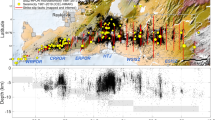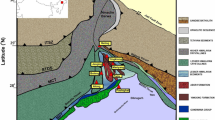Abstract
Zagros Foredeep Fault (ZFF) is located to the northeast of the Arabian plate and represents a discontinuous line that extends from southern Iran, through Iraqi territories to northeastern Syria. This research aims to study the seismotectonics of the Zagros Foredeep Fault at the collision zone between the Arabian and Eurasian plates. The results show that fifteen earthquake sequences have occurred on the Zagros Foredeep Fault. One of these sequences consists of more than 200 earthquakes in one month (April 2021). The study of the stress regime and the focal mechanism solutions in the Zagros Foredeep Fault shows that the fault has a reverse movement in most parts of it and a strike-slip at the northwestern part of it. Zagros Foredeep Fault was displaced by two strike-slip faults in Khuzestan that are extended from Basrah transversal basement faults. The mechanism of the Abdul-Aziz fault in Syria is a strike-slip with normal movement, which reveals that this fault is not a part of the Zagros Foredeep Fault. The authors believe that the Zagros fault formed in the Late Triassic period as a normal fault and reactivated with reverse movement in the Tertiary period during the collision between the Arabian-Eurasian plates.










Similar content being viewed by others
References
Abdulnaby W (2002) The structural and geotectonic of Jabal Sanam, South of Iraq. Unpublished Master Thesis, College of Science, University of Basrah, Iraq, 79
Abdulnaby W (2013) Seismotectonics of the northeastern margin of the Arabian plate in Iraq. Unpublished Doctoral Dissertation, the University of Arkansas at Little Rock, US, 209
Abdulnaby W (2019) Structural geology and neotectonics of Iraq, Northwest Zagros. In: In Developments in structural geology and tectonics, 3rd edn. Elsevier, New York, pp 53–73p
Abdulnaby W, Mahdi H, Numan NMS, Al-Shukri H (2013) Seismotectonics of the Bitlis–Zagros fold and thrust belt in Northern Iraq and surrounding regions from moment tensor analysis. Pure Appl Geophys 171:1237–1250p
Abdulnaby W, Mahdi H, Al-Shukri H, Numan N (2014) Stress patterns in Northern Iraq and surrounding regions from formal stress inversion of earthquake focal mechanism solutions. Pure Appl Geophys 171:2137–2153p
Abdulnaby W, Mahdi M, Al-Mohmed R, Mahdi H (2016a) Seismotectonic of Badra-Amarah fault, Iraq-Iran border. IOSR J Appl Geol Geophys (IOSR - JAGG) 4(3):27–33p
Abdulnaby W, Al-Mohmed R, Mahdi M (2016b) Seismicity and recent stress regime of Diyala City, Iraq – Iran border. Model Earth Syst Environ 2(3):142
Abdulnaby W, Motaghi K, Shabanian E, Mahdi H, Al-Shukri H, Gök R (2020) Crustal structure of the Mesopotamian plain, East of Iraq. Tectonics 39:e2020TC006225
Abdul-Wahe MK, Asfahani J (2018) The recent instrumental seismicity of Syria and its implications. Geofis Int 57:121–138p
Ahmad RA (2013) Seismic hazard assessment of Syria. J Seismol Earthquake Eng 15(1):1–13p
Aqrawi AA, Goff JC, Horbury AD, Saddoni FN (2010) The petroleum geology of Iraq. Scienti fi c Press Ltd., Cambrian Printers, Aberystwyth
Baker C, Jackson J, Priestley K (1993) Earth-quakes on the Kazerun line in the Zagros Mountains of Iran: strike-slip faulting within a fold-and-thrust belt. Geophys J Int 115:41–61p
Berberian M (1995) Master “blind” thrust faults hidden under the Zagros folds: active basement tectonics and surface morphotectonics. Tectonophysics 241(3-4):193–224p
Beydon ZR (1975) The petroleum geology of the Middle East. A synopsis. In: In the Petroleum Geology and Resources of the Middle East. Scientific press, Beacons Field
Buday T (1980) The regional geology of Iraq: stratigraphy and paleogeography. Dar Al-Kutib Publisher House, University of Mosul, Iraq, p 444
Darweesh HA, Obed AZM, Albadran BN (2017) Structural study of basins configuration in Mesopotamian area. Int J Eng Appl Sci 4(9):54–58p
Dong L, Luo Q (2022) Investigations and new insights on earthquake mechanics from fault slip experiments. Earth Sci Rev 228:104019. https://doi.org/10.1016/j.earscirev.2022.104019
Edgell HS (1992) Basement tectonics of Saudi Arabia as related to oil field structures. In: Rickard et al (eds) Basement tectonics, 9th edn. Kluwer Academic Publishers, Dordrecht, pp 169–193
Engdahl ER, Jackson J, Myers S, Bergman E, Priestley K (2006) Relocation and assessment of seismicity in the Iran region. Geophys J Int 167:761–778p
Falcon NL (1974) Southern Iran: Zagros Mountains. In: Spencer A (ed) Mesozoic-Cenozoic orogenic belts, data for orogenic studies: Alpine-Himalayan orogens, Geological Society, 4th edn. Special Publications, London, pp 199–211
Fouad SF (2010a) Tectonic evolution of the Mesopotamia Foredeep in Iraq. Iraqi Bull Geol Min 6(2):41–53p
Fouad SF (2010b) Tectonic map of Iraq, scale 1: 1000 000 (3rd ed.). edn. Geological Survey and Mineral Investigation (GEOSURV), Baghdad
Geiger L (1912) Probability method for the determination of earthquake epicenters from the arrival time only. Bull St Louis Univ 8:60–71p
Havskov H, Ottemöller L (2010) Routine data processing in earthquake seismology. Springer, Berlin, p 347
Heidbach O, Reinecker J, Tingay M, Müller B, Sperner B, Fuchs K, Wenzel F (2007) Plate boundary forces are not enough: second and third order stress patterns are highlighted in the World Stress Map database. Tectonics 26:TC6014
Heidbach O, Rajabi M, Reiter K, Ziegler M, Team WSM (2016) World stress map database release 2016. GFZ data services. https://doi.org/10.5880/WSM.2016.002
Herrmann RB, Ammon CJ (2002) Computer programs in seismology, version 3.30. Saint Louis University, Missouri
Hessami K, Koyi HA, Talbot CJ (2001) The significance of the strike-slip faulting in the basement of the Zagros fold and thrust belt. J Pet Geol 24:5–28p
Husseini MI (1989) Tectonic and deposition model of late Precambrian-Cambrian Arabian and Adjoining Plates. AAPG Bull 73(9):1117–1131p
Jaffar HM, Abdulnaby W (2018) Stress regime of Rumaila oilfield in Southern Iraq from borehole breakouts. J Appl Geol Geophys (IOSR-JAGG) 6(4):25–35p
Jassim SZ, Göff JC (2006) Geology of Iraq. Dolin, Prague and Moravian Museum, Brno, p 341
Karasözen E, Nissen E, Bergman EA, Ghods A (2019) Seismotectonics of the Zagros (Iran) from orogen-wide, calibrated earthquake relocations. J Geophys Res Solid Earth 124:9109–9129
Keilis-Borok VI, Knopoff L, Rotwain IM, Siderenko TM (1978) Bursts of seismicity as long term precursors of strong earthquakes. In: Proc. Conf. VI, methodology for identifying seismic gaps and soon to break gaps, p 351–386
Mobasher K (2007) Kinematic and tectonic significance of the fold- and fault-related fracture systems in the Zagros Mountains, Southern Iran. Doctoral dissertation. Georgia State University, Georgia, p 123
Mohammed SAG (2006) Megaseismic section across the northeastern slope of the Arabian Plate, Iraq. GeoArabia 11(4):77–90p
Najafi M, Beamud E, Ruh J, Mouthereau F, Tahmasbi A, Bernaola G, Yassaghi A, Motamedi H, Sherkati S, Goodarzi MGH, and Vergés J (2020) Pliocene growth of the dowlatabad syncline in frontal fars arc: folding propagation across the Zagros fold belt, Iran. GSA Bulletin. https://doi.org/10.1130/B35748.1
Numan NMS (1997) A plate tectonic scenario for the phanerozoic succession in Iraq. J Geol Soc Iraq 30(2):85–110p
Perotti C, Carruba S, Rinaldi M, Bertozzi G, Feltre L, Rahimi M (2011) The Qatar–South Fars Arch development (Arabian Platform, Persian Gulf): insights from seismic interpretation and analogue modelling. In new frontiers in tectonic research - at the midst of plate convergence, Edited by Uri Schattner. https://doi.org/10.5772/20299
Sepehr M, Cosgrove JW (2005) Role of the Kazerun Fault Zone in the formation and deformation of the Zagros Fold-thrust belt, Iran. Tectonics 24
Shams R, Fard I, Bouzari S, and Pourkermani M (2020) Investigating role of the Hormuz salt bodies in initiation and evolution of the strike-slip faults in the Fars zone of the Zagros fold and thrust belt: insights from seismic data and sandbox modeling. Pure Appl Geophys 177:4623–4642
Tavakoli F, Walpersdorf A, Authemayou C, Nankali H, Hatzfeld D, Tatar M, Djamour Y, Nilfouroushan F, and Cotte N (2008) Distribution of the right-lateral strike-slip motion from the main recent fault to the Kazerun Fault system (Zagros, Iran): evidence from present-day GPS velocities. Earth and Planetary Science Letters 275(3–4):342–347
Wessel P, Luis JF, Uieda L, Scharroo R, Wobbe F, Smith WHF, Tian D (2019) The generic map** tools version 6. Geochem Geophys Geosyst 20:5556–5564. https://doi.org/10.1029/2019GC008515
Acknowledgements
We are grateful to the Seismological Laboratory of the University of Basrah (SLUB) and the Iranian Seismological Center (IRSC) for providing the needed data that was used in this research. Also, we are grateful to the International Seismological Center (ISC), European-Mediterranean Seismological Centre (EMSC), Global Centroid Moment Tensor (GCMT), and World Stress Map (WSM) project for earthquake catalogs, focal mechanism solutions, and stress map of the study area. We also like to thank Robert Herrmann of the SLU for the CPS software package and Wessel et al. (2019) for the GMT 6.
Author information
Authors and Affiliations
Corresponding author
Ethics declarations
Conflict of interests
The authors declare that they have no competing interests.
Additional information
Responsible Editor: Longjun Dong
Supplementary information
ESM 1
(TXT 2 kb)
Rights and permissions
About this article
Cite this article
Al-Kaabi, M., Abdulnaby, W. Seismotectonics of the Zagros Foredeep Fault (ZFF), NE Arabian plate. Arab J Geosci 15, 1211 (2022). https://doi.org/10.1007/s12517-022-10448-0
Received:
Accepted:
Published:
DOI: https://doi.org/10.1007/s12517-022-10448-0




